Going strong – Denis Pugh
What is a strong grip? How can it benefit your game?
There are a number of reasons that explain why the world’s best players are hitting the ball further than ever before. Modern technology and superior levels of fitness are perhaps the two most obvious catalysts, but there has also been a shift in technique that we can clearly identify on tour.
Increasingly, with the emphasis on maximising the ‘width’ of swing and the ‘turn-speed’ of the body, the current generation of young players are using a ‘strong’ grip, in which the hands are rotated in a clockwise direction on the club.
Going strong – Denis Pugh
Though often overlooked, another reason players are hitting the ball so far is that they are hitting it so much straighter. The days of shaping the ball are virtually gone. When he talks about ‘moving the ball’ through the air, the modern professional is thinking in terms of perhaps three and five yards; in the past it might have been 15 or 20 yards. And the less deviation, the further it flies.
The difference is the ball, which has evolved in response to the demands of tour players who generate such fantastic speeds. To maximise distance, players are combining low spin rates with high launch angles off the tee (and less backspin means less sidespin), while modern materials used in the construction of the cover make it all possible without loss of feel or ‘stopping power’.
All of this has come about in a relatively short space of time. Think back to the way Greg Norman was spinning it in the mid- to late-1980s. He created such tremendous backspin with the irons that he actually lost control of the ball as it skewed back off the green. That’s something you rarely see today. Swing speeds up around the 120mph mark are being planted on a ball that is designed not to spin (too much), promising the optimum distance-enhancing trajectory off the tee while delivering exceptional levels of control with the irons.
The sum of all this is that young players feel they have a licence to swing hard, and they do so by utilising the ‘core’ of their body to create a rotational speed that accelerates the clubhead. And it is this change of emphasis that has led to the shift towards a ‘strong’ grip – one that enables the hands to remain passive as they return the clubface squarely to the ball. [A conventional grip would be outstripped by the sheer turn-speed that we see in the modern game, the tendency being to leave the clubface open through impact.]
So could a strong grip benefit your game? That depends on the nature of your swing and the way in which you create clubhead speed – and all is revealed.
Going strong – Denis Pugh
Should you be using a ‘strong’ grip?
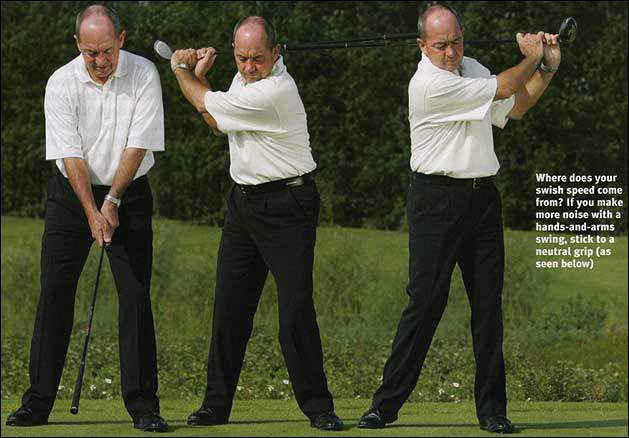
Going strong – Denis Pugh
I recommend the strong grip only to golfers who are prepared to invest time and effort on the practice ground and in the gym. As I mentioned already, a strong grip is designed to be used in conjunction with a strong body action – i.e. one that sees the ‘core’ muscles rotating to create a significant turn-speed that accelerates the hands and arms.
Though I am exaggerating it here to make my point, if you are a player who relies more on an independent hand-and-arm type swing to create speed (above), and are not using your body as an effective source of power, then you should use a neutral grip (see below) and develop a pure swinging motion of the arms and hands. A strong grip will only result in you hitting it shorter and/or more crooked – and likely as not fighting a duck-hook off the tee.
How to make a neutral grip

Going strong – Denis Pugh
– Start with the club low through the fingers of the left hand
– With the hand closed, 2-2½ knuckles should be visible on the back of the left hand
– Grip sits in the channel created by curled fingers of the right hand
– The two Vs point up between the chin and right shoulder
This makes it ‘strong’
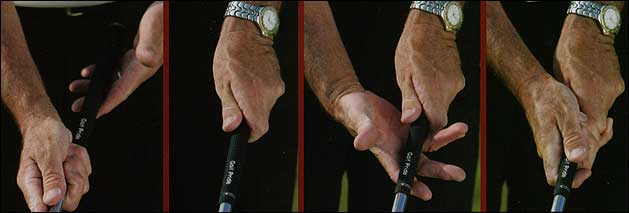
Going strong – Denis Pugh
– Start with the club low across base of the fingers of the left hand
– At least three (even four) knuckles should be visible on the back of left hand
– Right hand is applied from well underneath the shaft
– The two Vs now point towards the tip of your right shoulder
As a coach, you very quickly learn to recognize the movement of a player who uses the rotation of his body to generate the centrifugal forces that are channeled all the way down the shaft to create clubhead speed. But even to the untrained eye, I think you get a good sense of the difference between this sequence below and the hands-and-arms type of swing opposite. Clearly, the body is now much more involved, it’s a ‘dynamic’ motion, and as a result the swish-speed is much greater.
If this is more the way you swing the club, then a move to a stronger grip might be just the adjustment you need to hit longer and straighter shots. But be warned: if you do decide to experiment with a stronger grip, you will need to work on maintaining a strong body action, and ideally work on your physical conditioning away from the course so that the bigger muscles in your body can repeat this consistently.
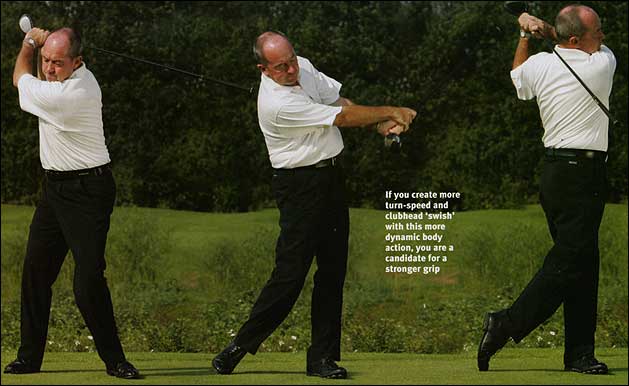
Going strong – Denis Pugh
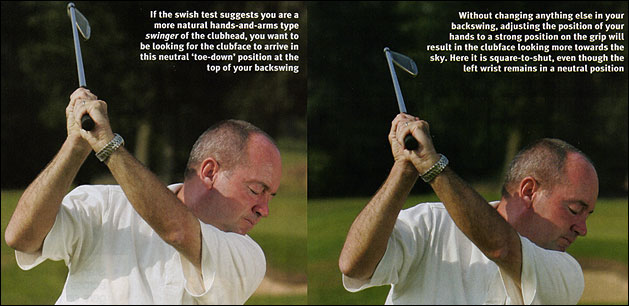
Going strong – Denis Pugh
With a neutral grip, look for ‘toe-down’ at the top
Once you have determined the type of grip that suits your style of play, what are the checkpoints you should be looking for to maintain a consistent swing? Well, the position of your hands on the grip certainly has a bearing on the position that you should look for at the top of the backswing – which after the set-up is where you want to be focusing your attention.
I don’t believe in getting bogged down with complicated thoughts on how to hinge the wrists in the course of making your backswing – best to let that happen naturally as you swing the clubhead to the top. With a neutral grip, you want to see the club in the toe-down position – i.e. square to even slightly open. That will help you to return the natural loft on the clubface to the ball when you swing the club through impact.
Any time you get a chance, stand in front of a mirror and look ‘down the line’ at these angles that characterize a good posture, then swing to the top and check out the position. Whether you use a neutral or a strong grip, a general sense of swinging the club up and over your right shoulder will get you on track.
Strong grip encourages clubface to look at the sky
The early wrist-hinge has become something of a cliche in teaching. But that’s not something you need to worry about when you adopt a strong grip. Because of the way you have placed the hands on the grip (i.e. both turned a little to the right), you have preset the wrist hinge and can concentrate fully on turning your body to create this backswing position. As you see here, the clubface is square to shut, even though the left wrist is in a neutral position. From here, the key is that you simply hold on and pull the club through the ball as you unwind hard through impact. The key is that the hands are essentially passive. That’s the feeling you want – the hands are going along for the ride. You don’t need any manipulation of the hands to strike solid shots.
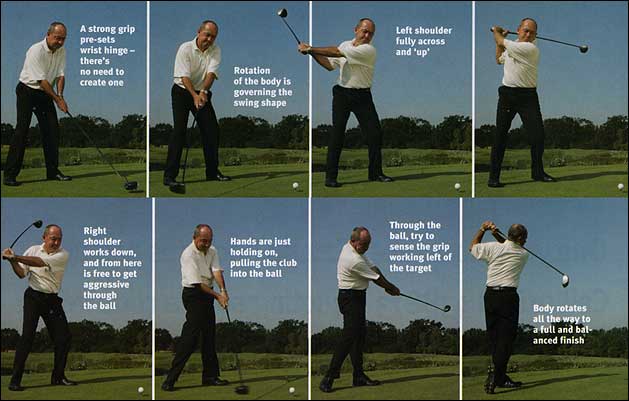
Going strong – Denis Pugh
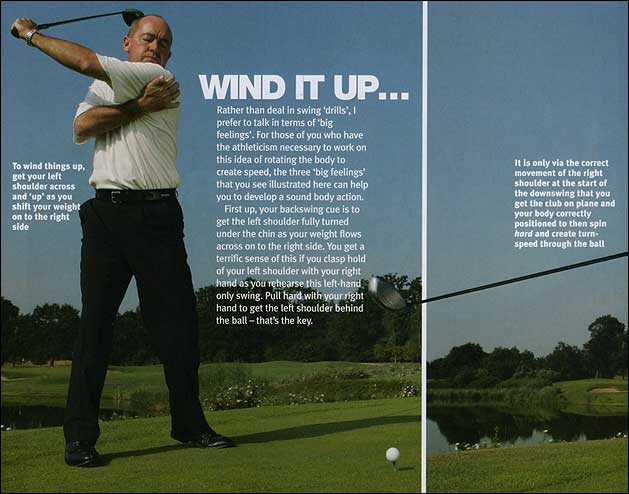
Going strong – Denis Pugh
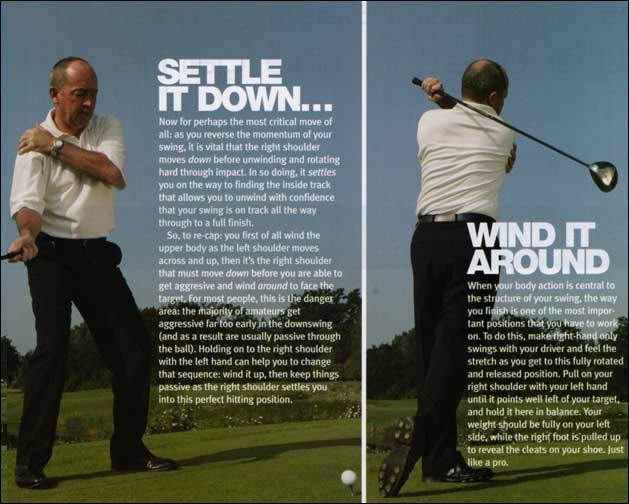
Going strong – Denis Pugh
The sub-text to this article is that strengthening your body action (along with your grip) is the key to a more consistent and more powerful way to play. Modern coaching has embraced this, and it’s no coincidence that the hot young players today are spending so much time in the gym, strengthening the ‘core’ muscles in the body. In many ways this simplifies the swing. The strong grip essentially presets your wrist action – so there is no need to get bogged down with an early wrist set. All you have to do is hold on as you wind and unwind to generate ‘turn-speed’ that accelerates the club.